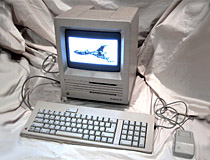The Apple Macintosh SE was released in March of 1987 as a successor to the Macintosh Plus. Like the Plus, the SE comes stock with one megabyte of RAM, but could be expanded up to a maximum of four megabytes by replacing some or all of the 256K SIMM modules with 1 megabyte SIMM's. The memory upgrade system was particularly painful, RAM could only be upgraded to four configurations, 1 megabyte, 2 megabytes, 2.5 megabytes, and 4 megabytes. To select which memory configuration you have installed, a resistor must be desoldered from the motherboard and moved to another location. The SE does a passable job of eliminating the Mac Plus's greatest flaw, the lack of secondary storage. Steve Jobs, the CEO of Apple at the time of the original Macintoshes release, forbade the inclusion of an internal hard drive because he did not like the noise that the spinning drive platters made. The SE was the first Macintosh to break this decree, and for the first time Macintosh users could actually get a hard drive inside their computer instead of resorting to a clunky add-on like the HD 20. The SE also brought another welcome addition to the Macintosh world, expansion card slots. Unlike the Plus, the SE has a single PDS slot that allows the user to install useful addons like a network card or an interface for an external monitor.
Unlike the Plus, the SE does not use rare and pricey 4 pin keyboards. The SE was the first compact Mac to include an ADB, the Apple communication standard that was used for keyboard and mouse connections from 1987 to 1998. In fact, the SE is arguably the first Mac ever to include an ADB port, the only other contender for that title is the Mac II, which was also released in March of 1987. The Mac II has a gestalt ID of 6, which is one digit higher than the SE's gestalt ID of 5, suggesting that the SE is the earlier machine. Regardless, the inclusion of ADB on the SE is nothing but a good thing for those who wish to actually use the computer. Unlike the hard to find 4 pin keyboard, ADB keyboards were manufactured in great numbers, and as such can still be bought in huge quantities for very reasonable prices.
More...




